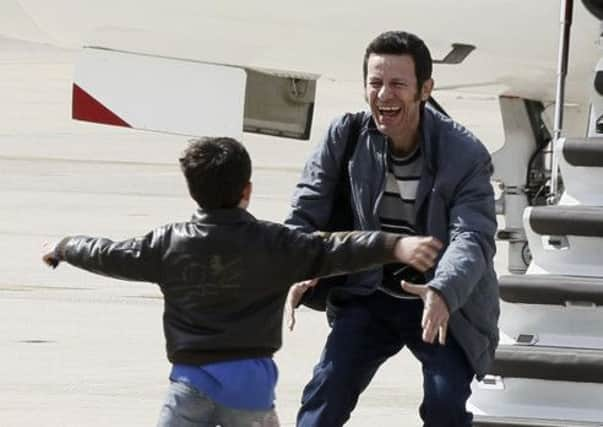IS hostage tells of mock execution by Emwazi


Javier Espinosa, a Spanish journalist, had been held by the radical IS since December 2013 and taken to the extremists’ stronghold near Aleppo, northern Syria, where he came into contact with British-born jihadists nicknamed the Beatles.
Writing in a Sunday newspaper, he described how Jihadi John, who was recently unmasked as 26-year-old Londoner Mohammed Emwazi, had been a lead figure in the group, also known as Isis, which took daily pleasure in telling them how they were going to behead them.
Advertisement
Hide AdAdvertisement
Hide AdA year after his emotional reunion with his children on the tarmac of a Spanish airport, the correspondent revealed the depths of horror he and dozens of other hostages faced daily.
He said: “The Beatles – that was our nickname for the three British militants guarding us – loved this sort of theatre. They had me sat on the floor, barefoot, with a shaven head, a thick beard and dressed in the ‘orange’ uniform’ that had made Guantanamo, the American prison, famous.
“Jihadi John wanted maximum drama. He had brought along an antique sword of the kind Muslim armies used in the Middle Ages. It was a blade of almost a metre in length with a silver handle.
“He caressed my neck with the blade but kept talking: ‘Feel it? Cold, isn’t it? Can you imagine the pain you’ll feel when it cuts? Unimaginable pain.’ After finishing with the sword he holstered his pistol, a Glock. He placed it against my head and pulled the trigger three times. Click. Click. Click. It’s called a mock execution. But not even this terrifying intimidation seemed to satisfy them.”
The militants then turned their attention to Mr Espinosa’s colleague, Ricardo Vilanova, threatening to shoot him, the correspondent for Spanish newspaper El Mundo said.
“It was one of several episodes of psychological and physical torture, privations and humiliations that became the daily reality for 23 hostages – Europeans, Americans and Latin Americans – held in Syria by Isis,” he added.
Among the most horrifying anecdotes was a threat to exhume the body of murdered Russian engineer Sergei Gorbunov and make remaining hostages sleep next to his bullet-riddled head.
“They liked scaring their captives, forcing us to look at photos of Sergei Gorbanov …’ You might end up with him, we’ll make you dig him up and put you in another tomb where you can sleep with him’,” recalled Mr Espinosa.
Advertisement
Hide AdAdvertisement
Hide AdMr Espinosa was snatched with his colleague photographer Ricardo Garcia Vilanova when the pair were working near the Turkish border in 2013. He was released in March last year after more than six months in IS hands.
Once across the border he contacted his newspaper and his wife – who later tweeted: “Pure happiness”.
Kuwait-born Emwazi had been pinpointed as a potential terrorist by the British authorities but was nonetheless able to travel to Syria in 2013 and join a group responsible for the murder of several western hostages.
In e-mail exchanges with a journalist, the University of Westminster computer programming graduate said he considered suicide after coming face to face with what he suspected to be a British spy as he attempted to sell a laptop computer in 2010.
Jihadi John rose to notoriety after he first appeared in a video posted online last August, in which he appeared to kill American journalist James Foley.
Dressed in black with a balaclava covering all but his eyes and the ridge of his nose, and a holster under his arm, he reappeared in videos of the beheadings of US journalist Steven Sotloff, British aid workers David Haines and Alan Henning, and American aid worker Peter Kassig. He has not appeared online since his identity was revealed.
FOLLOW US
SCOTSMAN TABLET AND MOBILE APPS